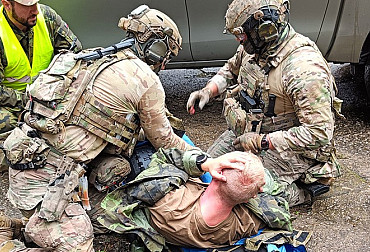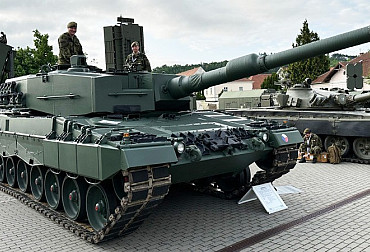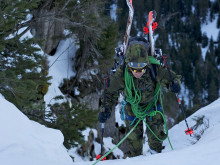Engineers transported tanks across the Labe river
To handle an eight-kilo mounting bar or to be able to rig the deck of a pontoon ship with a nearly forty-kilo anchor and a ramp arm - this is only a fraction of what every pontoonist has to master. It is the individual tasks that the Soldiers of the 15th Engineer Regiment, who are training for the 8th Enhanced Forward Presence (eFP) Latvia, have been practicing for the past 14 days.
The main task of the Pontoon Company is to assemble the so-called ferry vessel, which then transports the units' combat equipment over a water obstacle while moving. "We are currently practicing approaching the obstacle, dropping the boats and 6.75-metre-long pontoon parts into the water, and then joining the parts together to form a ferry vessel. This process is the main part of our work and our soldiers have to master the individual activities even with their eyes closed," Captain Jan Dvořák, commander of the 8th task group, explains. He adds that the engineers are also getting used to the new military equipment. "We have recently received new helmets and tactical vests. Although the weight of the tactical vests with ballistic plates is considerable, the soldiers have to fulfil their tasks even with them."

The preparatory engineer training with tactical elements at the water training ground in Litoměřice is the first major joint training of members of the 8th task force. The unit is due to replace its colleagues in Latvia early next year. "Not all of them are in original positions in the Pontoon Company, so they have to learn the professional part first of all. Fortunately, working on the pontoons is not that difficult to understand, it's more about physical exertion," Dvořák adds. Lieutenant T.M., the commander of the pontoon platoon, confirms this. "It is not a problem to replace a person in a basic function on a pontoon, but we have other specialties where the training takes longer. For example, a driver who has to learn how to use a winch when dropping and pulling a pontoon or a boat. Or boatmen. They in turn need to take the MO 634 boat course, which takes 2 to 3 weeks."
 Picture: Boats MO634 attached to a ferry vessel | Ministry of Defense of the Czech Republic
Picture: Boats MO634 attached to a ferry vessel | Ministry of Defense of the Czech Republic
Because there is a lot of work with heavy parts, it is important to follow safety precautions. "You don't hold these individual parts once during training, but you pick them up several times. You're lifting an anchor that's almost 40 kilos each time, then you're working with an 8-kilogram assembly bar, a perch, over and over again. After a whole day, everybody's had enough. The main thing is to keep your attention all the time, so you don't lose your fingers," says the commander of the first pontoon team, Staff Sergeant P.N.
 Picture: Transport of equipment over a water barrier | Ministry of Defense of the Czech Republic
Picture: Transport of equipment over a water barrier | Ministry of Defense of the Czech Republic
After the training in Litoměřice, further preparation awaits the future participants of the foreign mission. Whether it is KPV (comprehensive field training) with tactical preparation and combat drills or loading on the railway. The joint preparation of the task force will be concluded by a comprehensive field training in the Boletice military area, where the regimental commander will check the harmony of the whole unit in individual areas.
 Picture: Transport of equipment over a water barrier | Ministry of Defense of the Czech Republic
Picture: Transport of equipment over a water barrier | Ministry of Defense of the Czech Republic
The Czech Army units are operating in the Baltics within the framework of the Alliance's Enhanced Forward Presence (eFP). The Alliance Forward Presence is one of the main outcomes of the Warsaw Summit of July 2016. It consists of the creation of four enhanced battalion-strength battle groups deployed in Poland under US leadership, Lithuania under German leadership, Latvia under Canadian leadership and Estonia under UK leadership. The specific military contribution of the Member States is a confirmation of the national commitment under the NATO collective defence principle.
 Picture: Pulling out a pontoon | Ministry of Defense of the Czech Republic
Picture: Pulling out a pontoon | Ministry of Defense of the Czech Republic
Although our engineers are operating with handling boats and pontoon parts that have fallen into disrepair, this equipment is still serving our soldiers reasonably well and, thanks to its simplicity, any repairs can be carried out on site, unlike some modern pontoon sets.
However, modernisation of pontoon bridge sets will be necessary in the future. Already in 2019, for example, the IRB (Improved Ribbon Bridge) pontoon bridge set on a Tatra Force 8x8 chassis was presented at IDET. It is the result of cooperation between the Czech CSG holding, especially Excalibur Army, and GDELS. The IRB has the MLC 80 specification for tracked vehicles and MLC 96 for wheeled vehicles, so it is designed to support medium and heavy armoured vehicles. The IRB is compatible with other bridge systems used by NATO. It consists of river and coastal pontoon parts from which floating bridges or ferry seapods are assembled.
.jpg)
Picture: Pontoon bridge set IRB (Improved Ribbon Bridge) on Tatra Force 8x8 chassis was on display at IDET 2019 | CZ Defence
The IRB pontoon bridge kit can also include a Birdon BEB motorboat handling vessel, which has a crew of two with the ability to carry ten armed soldiers, i.e. soldiers with full equipment. The vessel can reach cruising speeds of up to 28 knots, or 52km/h. In the case of a harness, the BEB reaches a speed of up to 8 knots, or 15 km/h.





















